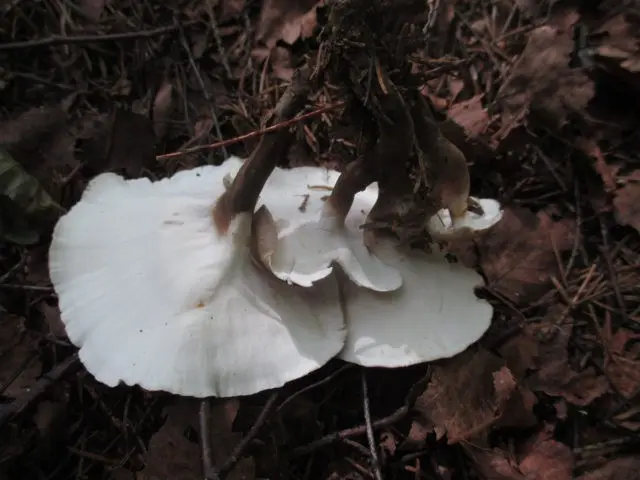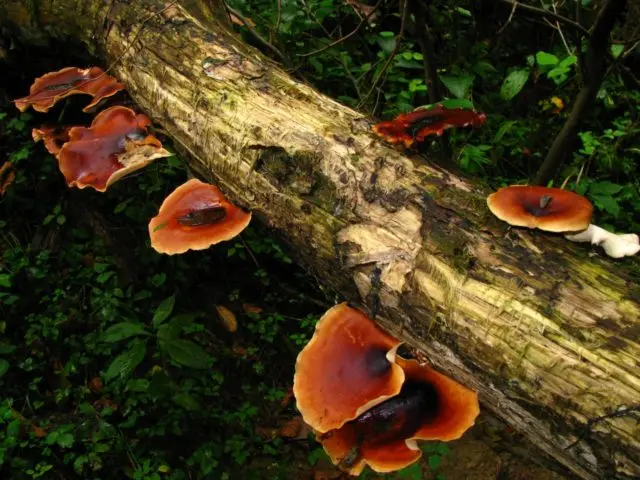Contents
The black-legged tinder fungus is a member of the Polypore family. It is also called blackfoot picipes. The assignment of a new name is due to a change in the classification of the fungus. Since 2016, it has been assigned to the genus Picipes.
Description of the black-legged tinder
The black-legged tinder fungus is distinguished by a thin, elongated leg. The diameter of the cap ranges from 3 to 8 cm. It has a funnel-shaped shape. As the fungus matures, a depression forms in its middle. The surface of the black-legged tinder fungus is covered with a glossy cloudy film. The color varies from brown to dark brown.
The fungus has a tubular hymenophore, which is located on the inside. The pores are small, having a rounded shape. At a young age, the pulp of the black tinder fungus is quite soft. Over time, it hardens and begins to crumble. No fluid is released at the fracture site. Contact with air does not change the color of the pulp.
In nature, the black-legged tinder fungus acts as a parasite. It destroys rotting wood, and further utilizes the remains of organic matter as a saprophyte. The Latin name for the fungus is Polyporus melanopus.

When harvesting, the fruiting bodies do not break, but are carefully cut with a knife at the base.
Where and how to grow
Most often, black-legged tinder fungi are found in deciduous forests. They are considered annual mushrooms, which are located near alder, birch and oak. Single specimens are localized in coniferous trees. The peak of fruiting falls on the period from mid-summer to November. In Our Country, picipes grows in the Far East. But it can also be found in other areas of the temperate forest belt of the Federation.
Is the mushroom edible or not?
Black-footed polyporus is classified as inedible. It has no nutritional value or taste. At the same time, it does not have a toxic effect on the human body.
Twins and their differences
In appearance, polyporus can be confused with other tinder fungi. But an experienced mushroom picker can always find the difference between them. In the black-footed picipes, a distinctive feature is a brown thin leg.
chestnut tinder fungus
The surface of young specimens is velvety, in more mature mushrooms it becomes smooth. The leg of the chestnut tinder fungus is located on the edge of the cap. It has a gradient shade – dark at the ground and light at the top.
The chestnut tinder fungus is ubiquitous in Australia, North America and western Europe. On the territory of Our Country, it grows mainly in Siberia and the Far East. Often it can be found near the scaly tinder fungus. The peak of fruiting falls on the period from late May to October. This species is not eaten. The scientific name is Picipes badius.

During rain, the surface of the tinder cap becomes oily.
Polyporus variant
Fruiting bodies are formed on thin fallen branches. The diameter of the twin’s cap can reach 5 cm. There is a small notch in the middle. In young mushrooms, the edges are slightly tucked down. As they mature, they open up. In rainy weather, radial stripes appear on the surface of the cap. Polyporus pulp is elastic and soft, with a characteristic aroma.
The features of the fungus include a developed leg, which has a black color. The tubular layer is white, the pores are small. Variable polyporus is not eaten, but this fungus is not toxic either. In Latin it is called Cerioporus varius.

Fruiting bodies are unsuitable for human consumption due to too hard pulp
Conclusion
The black-footed tinder fungus is found not only in single specimens, but also in fruits fused with each other. It can be found on dead wood and rotting branches. For mushroom pickers, it is of little interest due to the impossibility of eating.









